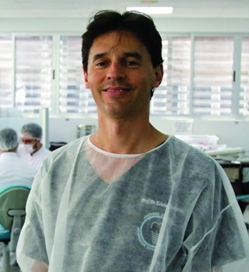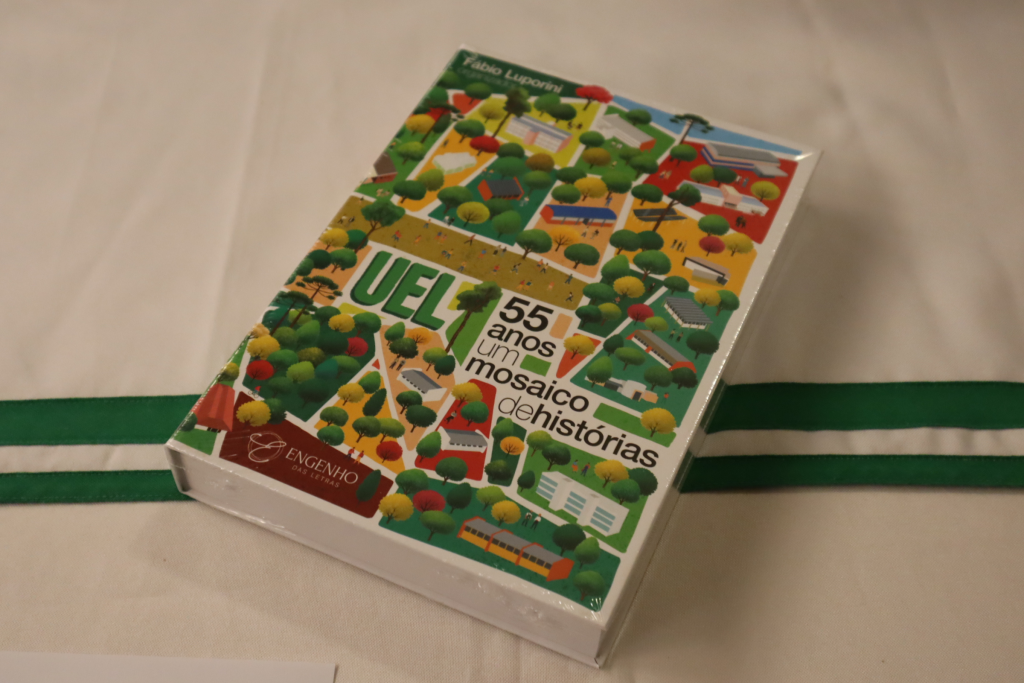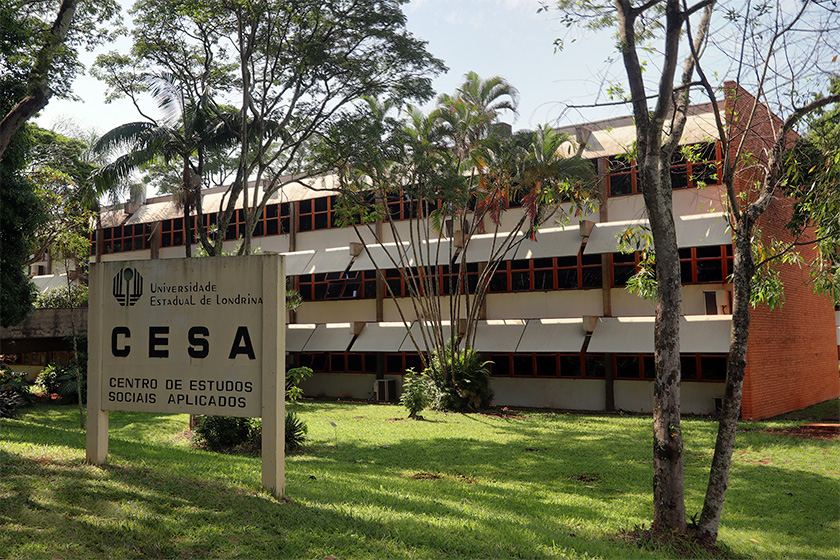[EN] What pain is this?
[EN] What pain is this?
Matéria originalmente publicada em português na edição nº1426 do Jornal Notícia. Traduzida para o inglês pela equipe do Paraná Fala Inglês (PFI).Professor Edwin Fernando Ruiz Contreras, from the Department of Restorative Dentistry, coordinates the “Study and Extension Group in Orofacial Pain and its Comorbidities” Complementary Education Program, which has been running since 2019 at the UEL Dental Clinic. The project originated from his postdoctoral studies at São Paulo State University “Júlio de Mesquita Filho” (Unesp)* in Araraquara in 2015, integrating his research into a specialized course due to the absence of a specific course in the dentistry program.
The course “Occlusion and Orofacial Pain”, based on the professor’s studies and is currently offered in the third year of the curriculum, serving as a prerequisite for participation in the Continuing Education Program (PFC) during the fourth year. According to Professor Edwin, the initiative’s main goal is to provide comprehensive care to the population, treating approximately 100 to 120 patients. He also mentions that treatments duration typically last two to three months, but it may vary depending on the diagnosis.
The success of the service provided by the Clinic’s Dental Emergency Room has generated significant demand, with over 300 people currently on the waiting list. Professor Edwin highlights the urgent need to expand the ongoing project. Initially starting with only six students, the program has now expanded to include 27 participants.
Despite this growth being positive, it remains insufficient to fully address the demand. The professor also expresses his satisfaction with the students’ enthusiastic participation. Additionally, he emphasizes that this is the only project in northern Paraná recognized by the Brazilian Orofacial Pain Society (SBDOF), which, according to him, “further contributes to an increasing demand”.
Which pains does the Program treat?
Contrary to what one might expect, the focus is not on toothache. The most common conditions treated are temporomandibular disorders (TMD) and headaches. TMD manifests as pain in the jaw, mandible, and around the ear, accompanied by discomfort during activities such as chewing, yawning, swallowing, or other daily activities. In some cases, the jaw may produce popping sounds with movement, and even light contact with the cheeks can cause severe, unbearable pain.
According to Professor Edwin, pain is a symptom with multifactorial causes, primarily physical (mechanical) or emotional. Less frequently, pain can result from inflammation in the orofacial region or from systemic diseases that affect various parts of the body. The types of pain also vary: muscle-related pain is typically described as pressure or crushing sensation, while joint pain tends to be sharp and needle-like. Neuropathic pain is often characterized by unpleasant sensations, such as burning.
The professor further explains that during the first appointment, an in-depth discussion with the patient is conducted, lasting up to an hour and a half. This session focuses on performing a thorough anamnesis, paying particular attention to habits that directly influence the pain.
Mild cases, which account for approximately 30%, can often be resolved within a few days if the patient follows the recommended guidelines. “About 55% of success in treatment depends on the patient,” says Professor Edwin, with the remaining 45% involving the dentist, physiotherapist, medications, and other factors. Surgical cases are rare, accounting for roughly 5%, with alternative treatment options including laser and acupuncture.
Although medication may be necessary, it is prescribed only after a thorough assessment. In fact, Professor Edwin notes that the project generally reduces the need for medication. “Many patients come to the clinic after having used painkillers and other medications, often without a medical or dental prescription,” he explains. The initial consultation also serves to educate the patient, offering detailed information about their condition, its causes, and the most effective therapeutic approach.
In this regard, the service plays a crucial role in prevention and education, countering unscientific information and applying scientific knowledge to specific cases. A clear example is bruxism, which involves excessive pressure on the teeth. Professor Edwin emphasizes that teeth should only come into contact during chewing; at other times, there should be no pressure between them. He also addresses a common myth: the real concern is not clenching the teeth during sleep, but the pressure exerted while awake, which he explains is even more damaging.
Anxiety and stress
Anxiety and stress are typically the primary causes. One recommendation for managing these issues is for patients to engage in leisure activities that promote relaxation. This does not always mean physical exercises, as it can sometimes exacerbate anxiety or stress. Activities like listening to music – provided it is a style the person enjoys – are also encouraged. High-pressure professions, such as police officers and firefighters, are often affected by orofacial pain due to the tension they experience. Additionally, the pandemic has significantly contributed to an increase in these cases.

Orofacial pain can also be linked to chronic illnesses, with many examples including restless legs syndrome, irritable bowel syndrome, and various “algias” like fibromyalgia, lumbago, and cervicalgia. Moreover, back pain can indeed radiate to the jaw. Professor Edwin explains that these chronic conditions send pain signals to the cerebral cortex, which can “confuse” the brain, leading to a phenomenon known as “referred pain”, i.e. pain felt in a different area from its source. He mentions cases where patients arrive at the clinic complaining of mouth pain, only for tests to reveal no underlying issues. In some cases, patients have even undergone unnecessary tooth extractions because the real source of their pain was elsewhere, not in the mouth.
The age group most affected by orofacial pain is the economically active population (ages 20 to 60), mainly due to work-related pressure. However, Professor Edwin warns that cases among children aged 7 to 10 are rising primarily due to excessive screen time. This overuse disrupts the quality of sleep, as the body has specific schedules for releasing hormones and substances that regulate sleep.
Staying up late in front of the TV or cell phones, disrupts this cycle, resulting in poor quality rest. Without adequate sleep, children spend more time on screens, creating a vicious cycle that leads to daytime sleepiness, lack of attention and concentration, and poor school performance. Professor Edwin advises that if you are not feeling sleepy, it is better to read a book or listen to calm, relaxing music rather than using screens. This recommendation applies to both adults and children.
Actions
In addition to providing services to the public, the PFC holds work meetings, case studies, and discussions of scientific articles, and has been presented at academic congresses. The project is also developing a database that will eventually serve as a foundation for scientific studies and publications. Last year, the program resulted in a Course Conclusion Paper (TCC), and currently, two students are using the database for their TCCs. Moreover, students are encouraged by Professor Edwin to participate in online courses offered by the Brazilian Orofacial Pain Society (SBDOF).
Professor Edwin has ambitious plans for the program’s future. He aims to increase the number of patients cataloged, which currently stands at around 150, with a goal of reaching 500. Another proposal is to expand the project into a university extension, allowing for curricular accreditation and scholarships for participating students. The ultimate goal, however, is to establish a Residency in Orofacial Pain. Despite the numerous dental schools in the country, Professor Edwin notes that there are fewer than 30 residency programs in this field.
* Universidade Estadual Paulista Júlio de Mesquita Filho (UNESP)
Versão em inglês: Ana Paula Luiz dos Santos Aires. Revisão de Mauricio Brancalhão e supervisão de Fernanda Machado Brener. PFI_ Programa Paraná fala Idiomas.
Matéria originalmente publicada em português na edição nº1426 do Jornal Notícia: Que dor é esta?




